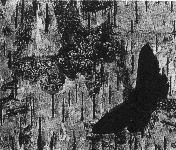Of course, I'm referring to the dog!
Tens of thousands of years ago there were no dogs, only wolves.
At some time long ago man started to domestic wolves, perhaps
starting with some young pups. Those that grew into acceptable
members of the tribe were allowed to stay under man's care. Some
of the wolves' offspring were as docile, or even more docile,
as their parents. The most friendly and sociable of each litter
of pups grew into the dogs that stayed with man's family. Over
the millennia these wolves diverged into a unique breed that not
only tolerated man but seemed to prefer the company. Man domesticated
wolves to help him hunt, pull his sleds, protect his home and
even shepherd his sheep!
More recently, dogs have been selected for very specific tasks,
behaviours and appearances. There are now dozens of "breeds"
of dogs and they come in a wide variety of forms.
The Alsatian, Great Dane, Retriever and Husky still retain the
size and strength of wolves but their behaviour is much more "refined".
Some dogs are so different from wolves that we tend to forget
about thier biological history and think of them as children in
the family. They have been bred to produce some of most "unwolf-like"
extremes - Dachshund, Pekinese, Chihuahua, etc.
All these are the product of thousands of years of artificial
selection on wolves!
Although primitive man had an incomplete understanding of heredity,
he was able to control the evolution of a select group of wolves
and thus "design" dogs.
Some of man's actions have resulted in evolution by accident.
A classic example of natural selection in action is the evolution
of the English Peppered Moth (Biston betularia). This story
illustrates an example of "industrial melanism" in the
United Kingdom. The materials that museums had been collecting
over the centuries provide the data.
|
This image shows two forms of this moth.
Moths collected before the industrial revolution were very light
in colour.
A dark (melanistic) form first appeared near Manchester
in 1848. By the middle of the 20th century more than 90% of all
English Peppered moths in polluted (industrial) areas were melanistic.
However, the frequency of the melanistic months dropped after
the Clean Air Acts were passed, and the light colour months have
been increasing in frequency ever since.
| 
|
What caused this pattern of change (from populations of moths
that were mostly light to populations that were mostly dark and
then back again to light coloured moths)?
Here's what happened.
This work was created by Dr Jamie Love  and
and  licensed under a Creative Commons Attribution-ShareAlike 4.0 International License.
licensed under a Creative Commons Attribution-ShareAlike 4.0 International License.
If you like, you can return to the Home Page.

 and
and  licensed under a Creative Commons Attribution-ShareAlike 4.0 International License.
licensed under a Creative Commons Attribution-ShareAlike 4.0 International License.